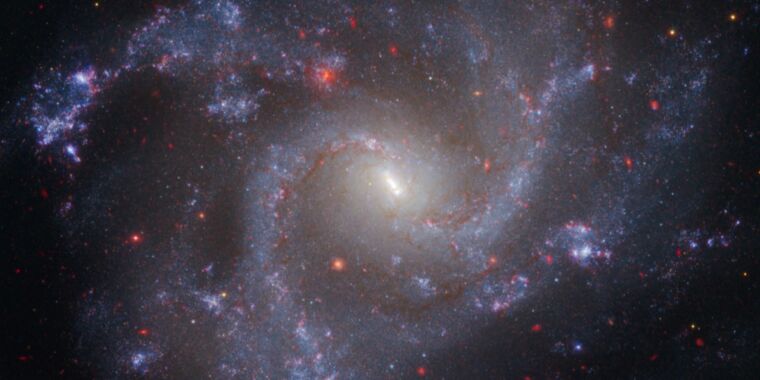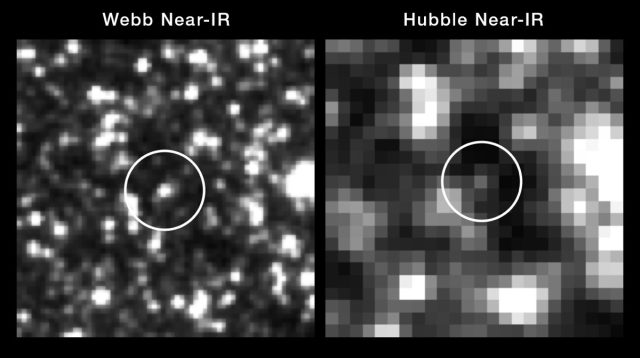Study: Conflicting values for Hubble constant not due to measurement error


NASA/ESA/CSA/STScI/A. Riess (JHU)
Astronomers have made new measurements of the Hubble Constant, a measure of how quickly the Universe is expanding, by combining data from the Hubble Space Telescope and the James Webb Space Telescope. Their results confirmed the accuracy of Hubble’s earlier measurement of the constant’s value, according to their recent paper published in The Astrophysical Journal Letters, with implications for a long-standing discrepancy in values obtained by different observational methods known as the “Hubble tension.”
There was a time when scientists believed the Universe was static, but that changed with Albert Einstein’s general theory of relativity. Alexander Friedmann published a set of equations showing that the Universe might actually be expanding in 1922, with Georges Lemaitre later making an independent derivation to arrive at that same conclusion. Edwin Hubble confirmed this expansion with observational data in 1929. Prior to this, Einstein had been trying to modify general relativity by adding a cosmological constant in order to get a static universe from his theory; after Hubble’s discovery, legend has it, he referred to that effort as his biggest blunder.
As previously reported, the Hubble constant is a measure of the universe’s expansion expressed in units of kilometers per second per megaparsec. So, each second, every megaparsec of the Universe expands by a certain number of kilometers. Another way to think of this is in terms of a relatively stationary object a megaparsec away: Each second, it gets a number of kilometers more distant.
How many kilometers? That’s the problem here. There are basically three methods scientists use to measure the Hubble constant: looking at nearby objects to see how fast they are moving, gravitational waves produced by colliding black holes or neutron stars, and measuring tiny deviations in the afterglow of the Big Bang known as the Cosmic Microwave Background (CMB). However, the various methods have come up with different values. For instance, tracking distant supernovae produced a value of 73 km/s Mpc, while measurements of the CMB using the Planck satellite produced a value of 67 km/s Mpc.
Just last year, researchers made a third, independent measure of the Universe’s expansion by tracking the behavior of a gravitationally lensed supernova, where the distortion in space-time caused by a massive object acts as a lens to magnify an object in the background. The best fits of those models all ended up slightly below the value of the Hubble constant derived from the CMB, with the difference being within the statistical error. Values closer to those derived from measurements of other supernovae were a considerably worse fit for the data. The method is new, with considerable uncertainties, but it did provide an independent means of getting at the Hubble Constant.

NASA/ESA/CSA/STScI/A. Riess (JHU)
“We’ve measured it using information in the cosmic microwave background and gotten one value,” Ars Science Editor John Timmer wrote. “And we’ve measured it using the apparent distance to objects in the present-day Universe and gotten a value that differs by about 10 percent. As far as anyone can tell, there’s nothing wrong with either measurement, and there’s no obvious way to get them to agree.” One hypothesis is that the early universe briefly experienced some kind of “kick” from repulsive gravity (akin to the notion of dark energy) that then mysteriously turned off and vanished. But it remains a speculative idea, albeit a potentially exciting one for physicists.
This latest measurement builds on last year’s confirmation based on Webb data that Hubble’s measurements of the expansion rate were accurate, at least for the first few “rungs” of the “cosmic distance ladder.” But there was still the possibility of as-yet-undetected errors that might increase the deeper (and hence further back in time) one looked into the universe, particularly for brightness measurements of more distant stars.
So a new team made additional observations of Cepheid variable stars—a total of 1,000 in five host galaxies as far out as 130 million light-years—and correlated them with the Hubble data. The Webb telescope is able to see past the interstellar dust that has made Hubble’s own images of those stars more blurry and overlapping, so astronomers could more easily distinguish between individual stars.
The results further confirmed the accuracy of the Hubble data. “We’ve now spanned the whole range of what Hubble observed, and we can rule out a measurement error as the cause of the Hubble Tension with very high confidence,” said co-author and team leader Adam Riess, a physicist at Johns Hopkins University. “Combining Webb and Hubble gives us the best of both worlds. We find that the Hubble measurements remain reliable as we climb farther along the cosmic distance ladder. With measurement errors negated, what remains is the real and exciting possibility that we have misunderstood the Universe.”
The Astrophysical Journal Letters, 2024. DOI: 10.3847/2041-8213/ad1ddd (About DOIs).
Source link




